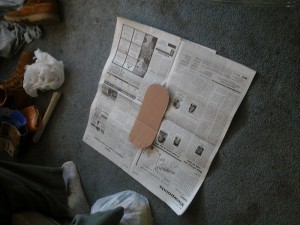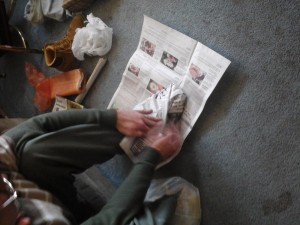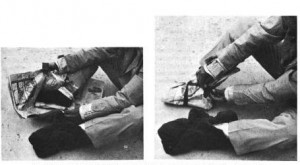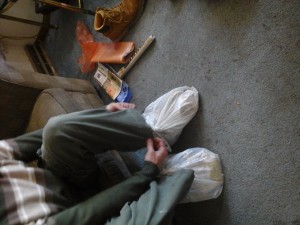Even if you’re not contemplating a nuclear war, the book Nuclear War Survival Skills by Cresson H. Kearney is chock full of interesting information. This book is freely available at various sites, including the Google Books link above. It is based on research done by the author while employed at the Oak Ridge National Laboratories, and was published and placed in the public domain after his retirement.
One of the items that I’ve always found intriguing is the description of homemade winter boots found in Chapter 15. Here are Kearney’s instructions for making boots from newspaper:
IMPROVISED WINTER FOOTWEAR
Cold-weather footwear that is warmer than all but the best-insulated winter boots can be improvised readily. The trick is learning how to tie the several insulating layers securely in place, so that you could hike for miles in the snow if necessary.
For use in dry snow, first tie a porous insulating layer—such as two bath towels or 10 big sheets of newspaper -over each shoe. If you have no lowheeled shoes, make a paper sole by folding 3 large newspaper sheets to make a sole that has 72 thicknesses of paper. Then proceed in the following manner:
1. Place your foot and the sole on 10 newspaper sheets, as pictured in Fig. 15.5.
2. Fold all the sheets over the top of your foot while keeping the sole in the proper place, as indicated in Fig. 15.5.
3. Use a strip of cloth about 3 inches wide and 5 feet long to tie the papers in front of your ankle with a single overhand knot (half of a square knot). With the same strip, tie another single overhand knot over the tendon behind the ankle. Finally, tie a bow knot in front of the ankle.
4. Cover the insulating layer with a tough fabric, such as canvas or burlap sack material; secure with a second strip of cloth and tie as described above.
If the snow is wet, place a piece of strong plastic film or coated fabric outside the insulating layer, after securing it with the first strip of cloth. The outer protective covering should be tied over the waterproofing, with the second strip of cloth securing both it and the waterproofing. (When resting or sleeping in a dry place, remove any moistureproof layer in the foot coverings, to let your feet dry.) Figure 15.6 shows a test subject’s waterproofed expedient footcovering, held in place as described above, after a 2-mile hike in wet snow. His feet were warm, and he had not stopped to tighten or adjust the cloth strips.
 Since the temperature this afternoon was about -10 degrees Fahrenheit, it seemed like an ideal day to test this expedient footwear. Since I was using it for only a short test close to home, I didn’t bother using the full ten sheets of newspaper called for by Kearney’s design. Instead, I started with a sole
Since the temperature this afternoon was about -10 degrees Fahrenheit, it seemed like an ideal day to test this expedient footwear. Since I was using it for only a short test close to home, I didn’t bother using the full ten sheets of newspaper called for by Kearney’s design. Instead, I started with a sole
 made of corrugated cardboard, and used only about three sheets of newspaper. I then tied these as indicated in Kearney’s instructions. I finished by covering them with a plastic grocery bag.
made of corrugated cardboard, and used only about three sheets of newspaper. I then tied these as indicated in Kearney’s instructions. I finished by covering them with a plastic grocery bag.
The completed shoes were surprisingly comfortable, and they also kept me surprisingly warm and dry as I walked around for a few minutes outside. I was able to walk quite comfortably through a snowbank.
With the very thin insulating layer, I’m sure that my feet would have gotten cold eventually. But the concept obviously works, and with more insulation, I think I could have stayed outside indefinitely.
Also, in a true survival situation, I would want to have the waterproof layer by considerably more durable than the thin grocery bags I used. Eventually, the thin plastic would have torn, my feet would have gotten wet, and I would be in a lot of trouble. But for my short venture outside, these proved perfectly adequate.
Of course, after seeing me test these, my kids wanted to give it a try themselves, and they both made themselves a set of emergency winter boots. So yes, I allowed my kids to go outside without shoes with the temperature of ten below zero.
For more interesting emergency preparedness books, see my listing of free e-books.



Pingback: 1944 Expedient Winter Clothing | OneTubeRadio.com